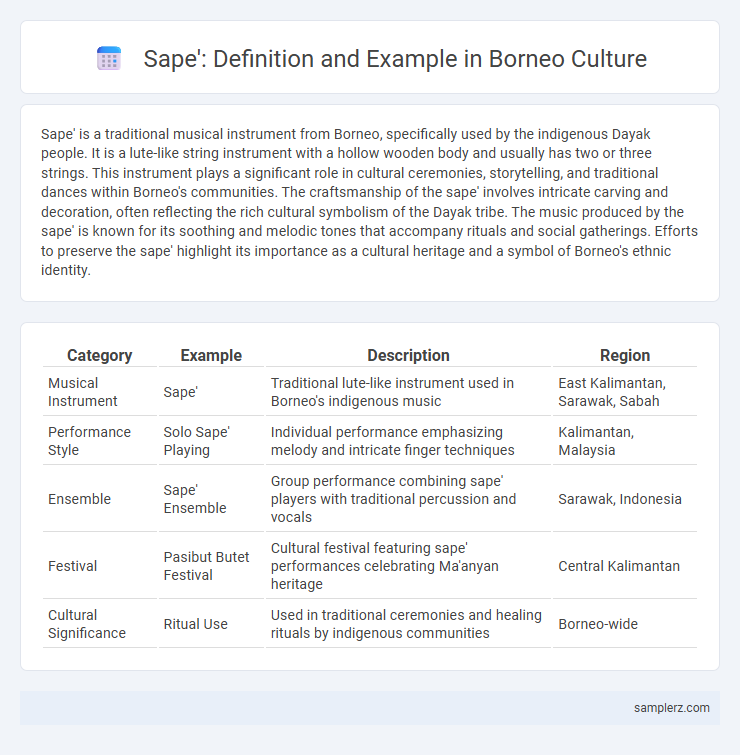Sape' is a traditional musical instrument from Borneo, specifically used by the indigenous Dayak people. It is a lute-like string instrument with a hollow wooden body and usually has two or three strings. This instrument plays a significant role in cultural ceremonies, storytelling, and traditional dances within Borneo's communities. The craftsmanship of the sape' involves intricate carving and decoration, often reflecting the rich cultural symbolism of the Dayak tribe. The music produced by the sape' is known for its soothing and melodic tones that accompany rituals and social gatherings. Efforts to preserve the sape' highlight its importance as a cultural heritage and a symbol of Borneo's ethnic identity.
Table of Comparison
| Category | Example | Description | Region |
|---|---|---|---|
| Musical Instrument | Sape' | Traditional lute-like instrument used in Borneo's indigenous music | East Kalimantan, Sarawak, Sabah |
| Performance Style | Solo Sape' Playing | Individual performance emphasizing melody and intricate finger techniques | Kalimantan, Malaysia |
| Ensemble | Sape' Ensemble | Group performance combining sape' players with traditional percussion and vocals | Sarawak, Indonesia |
| Festival | Pasibut Butet Festival | Cultural festival featuring sape' performances celebrating Ma'anyan heritage | Central Kalimantan |
| Cultural Significance | Ritual Use | Used in traditional ceremonies and healing rituals by indigenous communities | Borneo-wide |
Introduction to the Sape’: Borneo’s Iconic Traditional Lute
The sape' is a traditional lute originating from Borneo, renowned for its intricate carvings and melodic, soothing sounds that embody the cultural heritage of the Dayak people. Crafted from wood such as meranti or sungkai, the sape' features two to four strings and is played using finger plucking techniques to produce rhythmic tunes integral to rituals and festivals. This instrument serves as a symbol of Borneo's rich musical traditions and continues to influence contemporary indigenous music.
Origins and Historical Significance of the Sape’
The sape' is a traditional lute originating from the Dayak people of Borneo, primarily used in rituals and storytelling ceremonies. Its carved wooden body and distinct melodic tones date back centuries, symbolizing spiritual and cultural identity for indigenous communities. Historical records highlight the sape' as a conduit for preserving oral traditions and fostering social cohesion among the tribes in Borneo.
Cultural Symbolism of the Sape’ in Borneo Communities
Sape' is a traditional lute instrument deeply embedded in the cultural identity of Borneo's indigenous communities, symbolizing harmony and spiritual connection. Often used in rituals and festivals, the sape' embodies the ancestral heritage and storytelling traditions of the Dayak people. Its melodic tones not only preserve folklore but also reinforce social cohesion and cultural continuity in Borneo.
Sape’ in Traditional Ceremonies and Rituals
The sape', a traditional lute from Borneo, plays a vital role in Dayak cultural ceremonies and rituals, symbolizing spiritual connection and communal harmony. Often performed during harvest festivals, weddings, and healing ceremonies, the sape' music enhances the sacred atmosphere and preserves ancestral traditions. Its melodic tunes accompany dances and chants, embodying the cultural identity and heritage of the indigenous communities in Borneo.
Sape’ in Contemporary Borneo Music Scenes
Sape', a traditional lute from Borneo, plays a vital role in contemporary Borneo music scenes by blending indigenous sounds with modern genres like pop and reggae. This integration highlights cultural preservation while fostering innovation among young musicians in Sarawak and Kalimantan. Festivals and recording studios increasingly feature sape' performances, showcasing its adaptability and enduring cultural significance.
Prominent Sape’ Musicians and Their Contributions
Sape' is a traditional lute instrument integral to the cultural heritage of Borneo, especially among the Dayak communities. Prominent sape' musicians such as Mathew Ngau Jau and Alena Murang have revitalized and popularized this art form by blending traditional melodies with contemporary influences, enhancing global appreciation of Bornean culture. Their contributions extend to educational initiatives and performances that preserve sape' music while promoting cultural identity and ethnomusicology.
Sape’ Craftsmanship: Construction and Design Elements
The sape' from Borneo is a traditional boat-shaped lute carved intricately from a single jackfruit tree trunk, showcasing the Dayak people's craftsmanship. Its design features carefully hollowed-out interiors and ornate carvings reflecting local motifs and spiritual beliefs, optimizing resonance and aesthetic appeal. The use of natural materials like resin-based strings and vibrant pigments exemplifies sustainable practices intertwined with cultural identity.
Sape’ as a Medium for Storytelling and Folklore
The sape', a traditional lute from Borneo, serves as a powerful medium for storytelling and preserving local folklore through its melodic narratives. Skilled sape' players use intricate finger techniques to convey tales of ancient legends, myths, and cultural values embedded within the Dayak community. This musical instrument not only entertains but also functions as a living archive, sustaining Borneo's intangible cultural heritage.
Preservation and Revitalization Efforts for the Sape’
The sape', a traditional lute indigenous to Borneo's Dayak communities, plays a vital role in preserving cultural identity through music and dance. Preservation efforts include documentation, revival programs in local schools, and integration into contemporary performances to engage younger generations. Cultural organizations collaborate with artisans to safeguard craftsmanship techniques, ensuring the sape's legacy endures amid modernization pressures.
The Global Influence and Modern Adaptations of the Sape’
The sape' from Borneo, a traditional plucked lute, has gained global recognition for its unique melodic sound and intricate craftsmanship, influencing world music and fusion genres. Modern adaptations incorporate electric amplification and innovative designs, allowing artists to blend traditional rhythms with contemporary styles while preserving cultural heritage. Efforts to digitalize sape' music and promote cross-cultural collaborations further enhance its international presence, showcasing Borneo's rich artistic legacy on a global stage.

example of "sape’" in "Borneo Infographic
 samplerz.com
samplerz.com